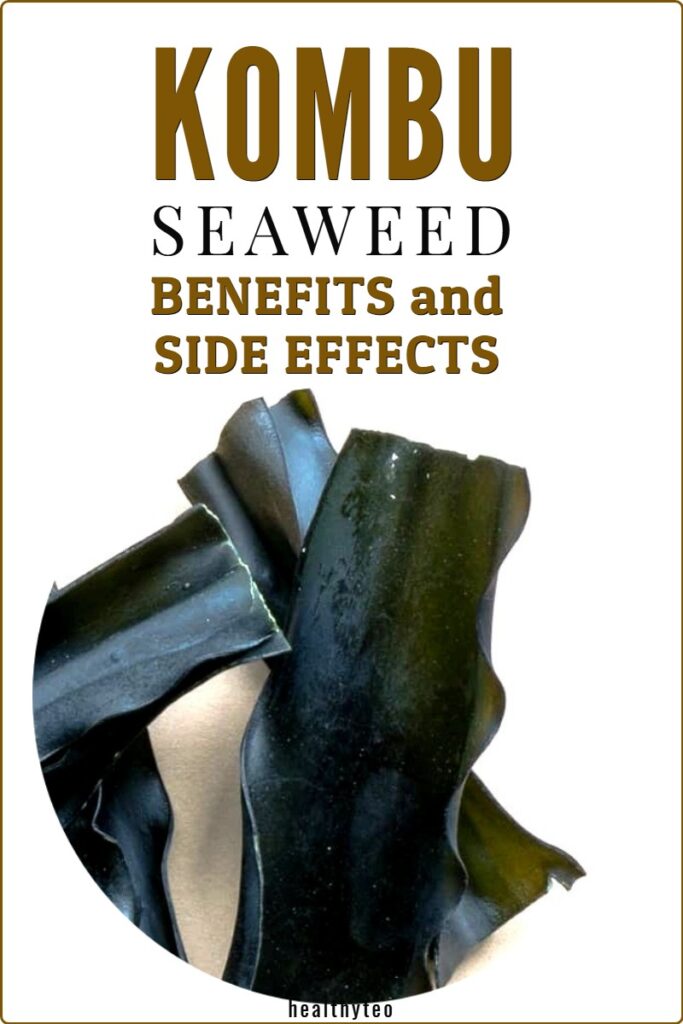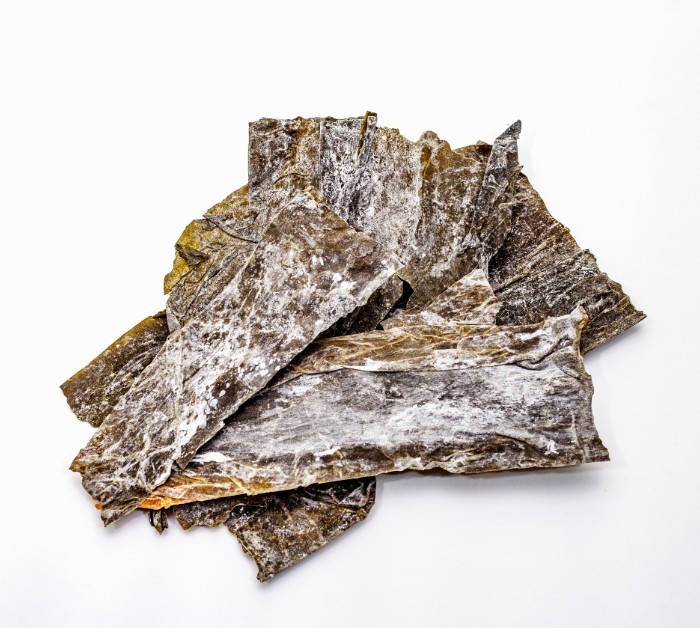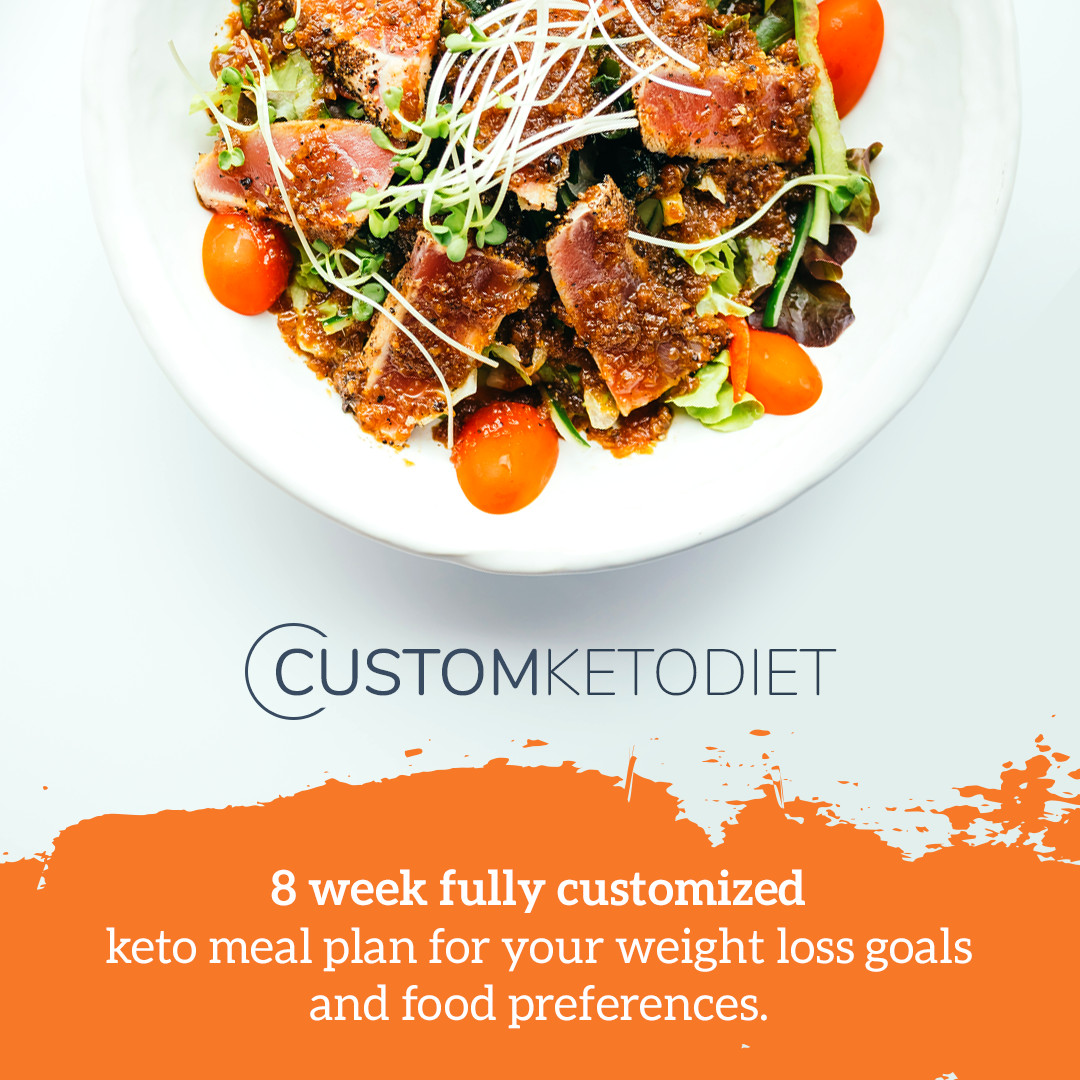Kombu Seaweed: Benefits and side effects of consuming the nutritional brown algae
Even it is present in our western diet for a long period of time, kombu seaweed as healthy food is using in the far east, especially in Japan for centuries.
We all know that the Japanese are one of the healthiest and longest-living people on Earth, and that is mainly to their healthy diet. When they are using kombu and other seaweeds as food there surely must be something beneficial to that.
This post may contain affiliate links, which means we may receive a small commission, at no cost to you, if you make a purchase through a link. For more information, please see our disclosure.
What Is Kombu?
Kombu is a subvariety of kelp, it is a brown sea alga that belongs to the group of brown seaweeds referred to as Laminariacea. Kelps are large brown algae seaweeds that make up the order Laminariales. There are about eighteen edible species in Laminariaceae and most of them, but not all, are called kombu.
Seaweed is mostly consumed in Japan and the three most popular seaweed products in Japan are nori (Porphyra), wakame (Undaria), and kombu (Laminaria).
Kombu seaweed has been consumed for many centuries mainly in the far east and its consumption is linked with longevity and health. The consumption of kombu in the Western World in the last decade has grown and this growth is a product of globalization and increased awareness of people to eat more healthy and natural food.
Kombu kelp posses a flavor and nutritional value unlike any other seaweed and it is called “the King of Seaweeds.” Rich in antioxidants, vitamins, minerals, and healthy fats kombu can be consumed fresh (sashimi), dried, pickled in vinegar, or tea (kombucha – different from Western fermented tea called kombucha).
Kombu Seaweed Benefits
Rich With Iodine
One of the most important benefits of kombu seaweed is that it is a great source of iodine. Iodine is an essential element required for thyroid hormone synthesis. It is also important in brain development and an important nutrient for women who are pregnant or breastfeeding.
Seaweeds have the ability to concentrate iodine from the ocean and certain types of brown seaweeds accumulate more than 30.000 times the iodine concentration of seawater.
The iodine content in over 20 species of red, green, and brown algae (seaweed) varies depending on species, harvest location, and preparation.
Kombu kelp can contain up to 241-4921 mg/kg. This provides almost 2000% of the recommended daily intake. The recommended daily intake (RDI) of iodine is 150 mcg per day for adults.
From all seaweeds kombu has the highest average iodine content 2523.5 mg/kg, followed by wakame 139.7 mg/kg and nori 36.9 mg/kg.
Excess iodine consumption is well tolerated in the majority of people but it can result in thyroid dysfunction, we will talk about this down here in the section side effects of kombu seaweed.
Seaweed is a great alternative to iodized salt which is a major iodine source in the Western Diet because it contains less sodium.
What happens with iodine content when you cook seaweed?
Seaweed is often cooked to flavor dishes or soup stocks before consumption.
When kombu is boiled in water for 15 minutes it can lose up to 99% of its iodine content. Processed kelp is often boiled for half an hour (“ao-kombu” or “kizami-kombu”) before hanging to dry. This process reduces the iodine seaweed content before consumption.
When kelp is used to flavor soup stocks the seaweed is removed after boiling, resulting in soup stock with high iodine levels. Results from research made on supermarket soups with kelp or kelp broth showed that the iodine content varies from 165 to 7,750 mcg (0.165 – 7.75mg) for a typical serving size of 0.25 L.
High Amount Of Omega-3 Fatty Acids
Omega-3 fatty acids are a super important nutrient and there are big chances that you’re not getting enough. Omega-3s are a nutrient powerhouse shown to improve mood and heart health. There are two kinds of Omega-3 acids that are important for our health: DHA and EPA.
DHA (docosahexaenoic acid) and EPA (eicosapentaenoic acid) are longer than other omega-3s so they make your membrane cells more fluid, which helps the brain, eye, and nerve cells function better. Most Americans only get just 100 mg a day of DHA/EPA, far little than recommended 250 mg.
One of many health benefits of kombu is that of all algae varieties kombu seaweed provides the highest amounts of both DHA and EPA. In 1 oz. serving you get 4-134 mg.
Contains Complex Polysaccharide Fucoidan
Fucoidan is a sulfated polysaccharide that can be found amongst a number of marine sources, like sea cucumbers or brown algae. This polysaccharide mainly consists of L-fucose and sulfate groups.
According to a review published in 2019 fucoidan has anti-inflammatory, antioxidant, and immunoregulatory properties. It has been shown to slow blood clotting, reduce lipogenesis (fat storage) and increase the breakdown of fat.
Many of these properties are confirmed with animal studies, but more research is indicated to determine its effects on humans.
Improves Digestion and Reduce Gas
Another benefit of consuming kombu is that contains certain amino acids that can help break down the heavy starches found in foods like beans. This allows for them to be digested much easier.
The presence of the glutamic acid (an amino acid used to form proteins) found in this brown algae provides its pleasantly savory flavor while the fiber helps digestion overall. The glutamic acid is responsible for umami taste (the Japanese word used for a basic taste identified in 1908).
Umami or savoriness is one of the five basic tastes (sweetness, sourness, bitterness, and saltiness). It has been described as savory and is characteristic of broths and cooked meats.
One of the best benefits that kombu can provide is minimizing the gas effects for those who struggle with intestinal gas. The main reason for this is the missing enzymes required to break down raffinose sugars found in some foods like beans, cabbage, broccoli, asparagus, whole grains, and other vegetables.
Bacteria in our gut like these sugars, releasing hydrogen and carbon dioxide and therefore gas and even bloated stomach. Kombu contains digestive enzymes that can offer a more pleasant experience when consuming legumes.
Rich In Vitamins And Minerals
Kombu is a nutrition powerhouse, rich in vitamins and minerals. One seven inch piece of kombu contains 0 grams fat, 0 grams cholesterol, 10 calories, 180 milligrams sodium, 340 mg potassium, 2 grams carbohydrates, 2 grams fiber, 4 percent calcium and 12 percent magnesium.
This great brown alga contains A, B, C, E, and K vitamins, iodine, iron, manganese, and copper.
Iron plays a vital role in our bodies due to its role in the production of hemoglobin. Kombu may be able to provide much-needed iron to maintain good health. If iron levels in your body are at low levels you may feel tired or have shortness of breath.
Thankfully the iron content in sea vegetables like kombu helps prevent iron deficiency and anemic symptoms.
Kombu Seaweed Side Effects
When cooked and properly prepared, eating kombu seaweed has been proven beneficial, however, some people are sensitive to seaweed and sea vegetables and it can trigger some allergic reactions:
- Itching
- Skin Rashes
- Hives
- Watery or Itchy Eyes
- Runny Nose
Because kombu is so high in iodine, if you eat large amounts of iodine toxicity can occur. Let’s repeat again if you eat large amounts.
Most adults should try to get about 150 micrograms (mcg) of iodine per day. According to Linus Pauling Institute, the maximum amount of iodine someone can consume without negative side effects is:
- children 1-3 years 200 mcg per day
- children 4-8 years 300 mcg per day
- children 9-13 years 600 mcg per day
- adolescents 14-18 years 900 mcg per day
- adults 19 years and older 1,100 mcg per day
Signs and symptoms of iodine toxicity include
- Abdominal Pain
- Diarrhea
- Fever
- Metallic Taste In Mouth
- Salivation
- Shortness Of Breath
- Vomiting
- Thirst
- No Urine Output
In cultures that eat a lot of seaweed like Japan, people sometimes consume thousands of mcg of iodine per day. For example, in a review published in 2001, the results show that people in Japan consume from 1000-3000 mcg of iodine per day, mostly from seaweed.
This causes iodine-induced hyperthyroidism to be more common in Japan, however, the same review suggests that this higher intake of iodine may play a vital role in Japan’s low cancer rates and long life expectancy.
There is no worry about iodine toxicity if you don’t eat large amounts of kombu. Everything in moderation is good, this is an important rule that must be followed even when it comes to food too.
Important: If you are allergic to fish or shellfish you shouldn’t consume kombu or any kind of seaweed because there may have traces of fish. For people on potassium or thyroid medications or supplements, seaweed can be problematic due to its iodine and potassium content.
Kombu contains vitamin K which plays a role in blood clotting. Vitamin K is important for your blood thinner medications to work properly. If you are taking blood thinner it is a good idea to consult with your physician before including kombu in your diet.
If you have some health issues we recommend discussing them with your healthcare provider before you decide to consume kombu or any other seaweed.
What Is The Best Kombu?
Fresh or raw kombu is preferred as it contains the largest amount of nutrients. However, dried and frozen kombu have a longer shelf life. The quality of seaweed you choose will determine the health benefit of kombu you receive.
The best Kombu you can choose is often sold in sheets or strips, has a very dark color and you can easily add to miso soup, legumes, and salads.
We recommend this type of kombu, named “Ma-Kombu”, prized not only for its abundance of vitamins, minerals and trace elements but also for its natural glutamic salts that makes it a great flavoring agent. This kombu grows wild in the sea and is gathered by hand from the sea while the plant is still living.
How To Prepare Kombu Seaweed
Kombu can be added to vegetables, soups, grains, beans, or stew dishes and it is an essential ingredient of Japanese noodle broth dashi (recipe below).
Fresh kombu can be grilled, baked, pan-fried, or steamed. Some people prefer to eat it raw, but heat softens it and makes it easier for consumption.
Dried varieties are great for seasoning and salting and they are ideal for making dashi soup and wrapping around fish before popping it on a barbeque (rehydrate it for 8-10 minutes in water so that the seaweed becomes malleable. The fish will gently steam inside the leaf).
Pickled seaweed is good for making teas and sources for meats and seafood.
Before cooking rinse kombu under running water for 30 sec. Let it stay in warm water for 10-15 minutes until it gets softer. Once softened you can add kombu to vegetables, soups, or stews while they cook.
Remove the kombu when the meal is done, the nutrition will have seeped out in your meal. If you boil seaweed in an uncovered pot and discard the water you will lose great content of the essential vitamins and minerals.
Good To Know: Boiling seaweed in water for 15-30 minutes is an efficient way to reduce the iodine content by up to 99%. Due to such high losses of iodine, processed or cooked seaweed doesn’t carry any significant risk of iodine toxicity. It is not the case with raw kelp products, if not treated the percent of iodine stays the same.
In its powdered form, kombu can be mixed with Japanese green tea to make the hot Japanese drink kombucha, not to be confused with the fermented fruit drink that is also called kombucha in the west.
Kombu to soften beans – All you need to do is to add dried kombu seaweed to your cooking water. The amino acids in kombu will soften the beans and make them more digestible. The deep flavor will season the beans, adding an umami edge.
How Much Kombu Should I Use?
The typical serving size for use in recipes is about one dry sheet of kombu. If you are using the powdered form of kombu we recommend following the serving size recommendations written on the package.
Kombu Dashi Recipe
Dashi is an essential broth base for most Japanese dishes. There are many different ways to make dashi, but we chose the easiest and simplest one.
Ingredients:
- 1 piece (4 inches) dried kombu
- 4 cups of water
Directions:
Cut the kombu sheets into 1-inch pieces and place them into a saucepan along with the water. Bring to boil, after that bring the heat to medium-low and simmer for 20 minutes. Remove the pan from the heat and leave it for few minutes. Strain through a mesh strainer before using it.
Dashi should smell like tea and have goldish color. After cooling you can keep dashi refrigerated for 14 days and use it when you want. The stock will smell sour when it has gone off.

Final thoughts about kombu seaweed benefits and side effects:
Kombu, brown sea algae have been used as food for centuries in the far east, especially in Japan. Rich with vitamins, minerals, fatty acids, and iodine, is beneficial for our health. It is so easy to use in different foods, like soups, stews, vegetables, beans, and even for wrapping fish for a barbeque.
The only precaution should have people with thyroid problems or those who take potassium and thyroid supplements, and pregnant women too. Due to high iodine content, we recommend consulting with your doctor before start using kombu in your meals.




